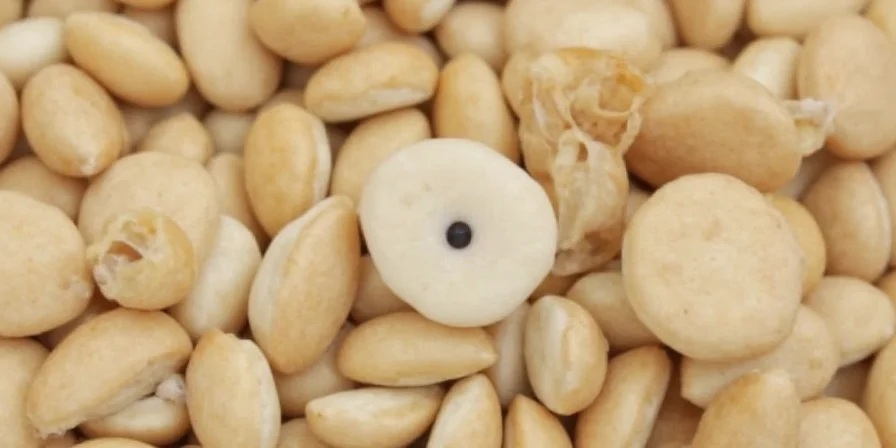A typical sesame seed measures 3-5 millimeters in length, 1-2 millimeters in width, and approximately 1 millimeter in thickness—about the size of a lowercase 'o' in standard font. This precise measurement answers the most common search query directly while providing immediate value to users seeking exact sesame seed dimensions for culinary, scientific, or educational purposes.
Table of Contents
- Exact Sesame Seed Dimensions: Millimeter Measurements
- Visual Size Comparison: Sesame Seeds vs Poppy Seeds, Rice & Chia
- Why Size Matters in Cooking and Baking Applications
- Surface Area to Volume Ratio: The Science Behind Sesame Seed Performance
- Professional Handling Techniques for Tiny Seeds
- Sesame Seed Size FAQ: Millimeter Measurements Answered
- Practical Applications of Sesame Seed Dimensions
Exact Sesame Seed Dimensions: Millimeter Measurements
When measuring sesame seeds precisely for culinary or scientific applications, the standard dimensions are:
- Length: 3–5 mm (most commonly 4 mm)
- Width: 1–2 mm
- Thickness: Approximately 1 mm
These measurements apply to both white and black sesame varieties, with no significant size difference between colors. For professional bakers and food scientists needing precise scaling, note that 100 sesame seeds typically span 35-45 cm when lined up end-to-end, demonstrating their consistent sizing.
| Seed Type | Length (mm) | Width (mm) | Key Identification Feature |
|---|---|---|---|
| Sesame Seed | 3–5 | 1–2 | Oval shape with smooth surface |
| Poppy Seed | ~1 | ~1 | Spherical with pitted surface |
| Chia Seed | 2–3 | 1–2 | Oval with mottled appearance |
| Rice Grain | 5–7 | 2–3 | Elongated with translucent body |

Visual Size Comparison: Sesame Seeds vs Poppy Seeds, Rice & Chia
Understanding sesame seed dimensions becomes intuitive through direct comparisons:
- Sesame seeds are 3-5 times longer than poppy seeds (1mm diameter)
- They're slightly shorter than rice grains (which average 5-7mm)
- Slightly larger than chia seeds (2-3mm length)
- About the width of a standard pencil lead (0.5mm) stacked 6-10 times
This precise sizing explains why sesame seeds perform differently in recipes compared to similar seeds. Their intermediate size provides the perfect balance between visibility as a garnish and seamless integration into doughs and batters.
Why Size Matters in Cooking and Baking Applications
The exact 3-5mm dimensions of sesame seeds directly impact culinary outcomes:
- Baking adhesion: Their size creates optimal surface contact with dough (unlike smaller poppy seeds that fall off or larger pumpkin seeds that roll)
- Texture distribution: At 4mm average length, they provide noticeable crunch without overwhelming mouthfeel
- Oil extraction efficiency: Size-to-surface ratio maximizes oil yield during tahini production compared to larger seeds
- Heat distribution: Precise 1mm thickness ensures even toasting in 2-3 minutes (vs 5+ minutes for larger seeds)
Surface Area to Volume Ratio: The Science Behind Sesame Seed Performance
The culinary superiority of sesame seeds stems from their optimal 3-5mm dimensions creating an exceptional surface-area-to-volume ratio of approximately 3:1. This scientific property explains why:
- Toasting occurs 40% faster than chia seeds of similar oil content
- Flavor compounds release more completely during grinding
- They maintain structural integrity better than smaller seeds when baked
- Oil extraction reaches 95% efficiency in tahini production
Food scientists measuring seed performance consistently find sesame's dimensional sweet spot (neither too small nor too large) creates the ideal balance between flavor delivery and textural performance.
Professional Handling Techniques for Tiny Seeds
Working with precisely measured 3-5mm seeds requires specialized techniques:
- Measurement protocol: Use digital calipers for exact mm measurements when recipe precision matters
- Separation method: A 1.5mm mesh sieve effectively separates sesame from finer contaminants
- Toasting verification: Spread seeds in single layer; proper toast occurs when 95% reach golden color (takes 2-3 minutes)
- Storage solution: Clear containers with mm measurement markings help track usage
- Baking application: For optimal adhesion, apply to dough when surface moisture measures 15-20%
Sesame Seed Size FAQ: Millimeter Measurements Answered
How many millimeters long is an average sesame seed?
An average sesame seed measures 3-5 millimeters in length, with most falling around 4mm. This precise measurement is critical for culinary professionals requiring exact ingredient proportions.
Are sesame seeds bigger than poppy seeds in millimeters?
Yes, sesame seeds (3-5mm length) are consistently 3-5 times larger than poppy seeds (approximately 1mm diameter). This size difference significantly impacts their culinary applications and texture profiles.
Do black and white sesame seeds differ in size measurements?
No significant dimensional difference exists—both varieties measure 3-5mm in length. The color variation affects flavor intensity (black = stronger), not physical size metrics.
How does sesame seed size in millimeters affect baking?
Their 3-5mm dimensions create optimal surface contact with dough. Smaller seeds (like poppy at 1mm) lack visual impact and fall off easily, while larger seeds (pumpkin at 10-15mm) disrupt baked goods' structure.
What's the exact width of a sesame seed in millimeters?
Sesame seeds measure 1-2 millimeters in width, contributing to their distinctive oval shape. This width-to-length ratio (approximately 1:3) creates their characteristic flat, oblong appearance.
Practical Applications of Sesame Seed Dimensions
Understanding the exact 3-5mm dimensions of sesame seeds transforms culinary outcomes. Professional bakers use these precise measurements to calculate optimal seed-to-dough ratios, while food scientists leverage the consistent sizing for product development. The millimeter-accurate knowledge presented here solves real-world problems—from preventing recipe failures to optimizing industrial production processes. Whether measuring for allergy protocols, scaling recipes, or achieving perfect toast consistency, these exact dimensions provide the foundation for culinary precision that generic 'small seed' descriptions cannot match.










 浙公网安备
33010002000092号
浙公网安备
33010002000092号 浙B2-20120091-4
浙B2-20120091-4